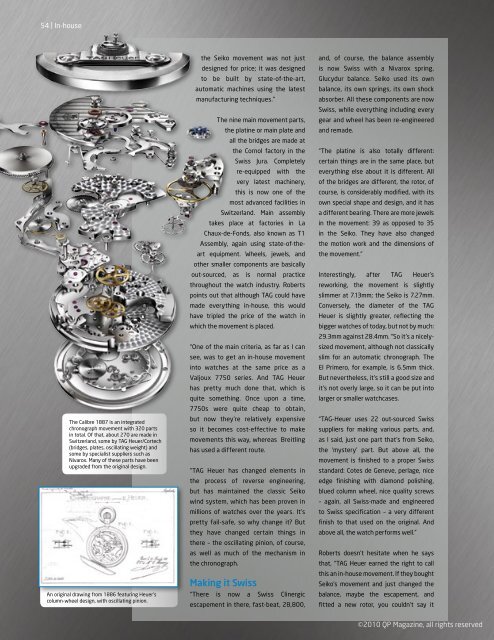in the Movement
in the Movement
in the Movement
You also want an ePaper? Increase the reach of your titles
YUMPU automatically turns print PDFs into web optimized ePapers that Google loves.
54 | In-house<br />
The Calibre 1887 is an <strong>in</strong>tegrated<br />
chronograph movement with 320 parts<br />
<strong>in</strong> total. Of that, about 270 are made <strong>in</strong><br />
Switzerland, some by TAG Heuer/Cortech<br />
(bridges, plates, oscillat<strong>in</strong>g weight) and<br />
some by specialist suppliers such as<br />
Nivarox. Many of <strong>the</strong>se parts have been<br />
upgraded from <strong>the</strong> orig<strong>in</strong>al design.<br />
An orig<strong>in</strong>al draw<strong>in</strong>g from 1886 featur<strong>in</strong>g Heuer’s<br />
column-wheel design, with oscillat<strong>in</strong>g p<strong>in</strong>ion.<br />
<strong>the</strong> Seiko movement was not just<br />
designed for price; it was designed<br />
to be built by state-of-<strong>the</strong>-art,<br />
automatic mach<strong>in</strong>es us<strong>in</strong>g <strong>the</strong> latest<br />
manufactur<strong>in</strong>g techniques.”<br />
The n<strong>in</strong>e ma<strong>in</strong> movement parts,<br />
<strong>the</strong> plat<strong>in</strong>e or ma<strong>in</strong> plate and<br />
all <strong>the</strong> bridges are made at<br />
<strong>the</strong> Cornol factory <strong>in</strong> <strong>the</strong><br />
Swiss Jura. Completely<br />
re-equipped with <strong>the</strong><br />
very latest mach<strong>in</strong>ery,<br />
this is now one of <strong>the</strong><br />
most advanced facilities <strong>in</strong><br />
Switzerland. Ma<strong>in</strong> assembly<br />
takes place at factories <strong>in</strong> La<br />
Chaux-de-Fonds, also known as T1<br />
Assembly, aga<strong>in</strong> us<strong>in</strong>g state-of-<strong>the</strong>art<br />
equipment. Wheels, jewels, and<br />
o<strong>the</strong>r smaller components are basically<br />
out-sourced, as is normal practice<br />
throughout <strong>the</strong> watch <strong>in</strong>dustry. Roberts<br />
po<strong>in</strong>ts out that although TAG could have<br />
made everyth<strong>in</strong>g <strong>in</strong>-house, this would<br />
have tripled <strong>the</strong> price of <strong>the</strong> watch <strong>in</strong><br />
which <strong>the</strong> movement is placed.<br />
“One of <strong>the</strong> ma<strong>in</strong> criteria, as far as I can<br />
see, was to get an <strong>in</strong>-house movement<br />
<strong>in</strong>to watches at <strong>the</strong> same price as a<br />
Valjoux 7750 series. And TAG Heuer<br />
has pretty much done that, which is<br />
quite someth<strong>in</strong>g. Once upon a time,<br />
7750s were quite cheap to obta<strong>in</strong>,<br />
but now <strong>the</strong>y’re relatively expensive<br />
so it becomes cost-effective to make<br />
movements this way, whereas Breitl<strong>in</strong>g<br />
has used a different route.<br />
“TAG Heuer has changed elements <strong>in</strong><br />
<strong>the</strong> process of reverse eng<strong>in</strong>eer<strong>in</strong>g,<br />
but has ma<strong>in</strong>ta<strong>in</strong>ed <strong>the</strong> classic Seiko<br />
w<strong>in</strong>d system, which has been proven <strong>in</strong><br />
millions of watches over <strong>the</strong> years. It’s<br />
pretty fail-safe, so why change it? But<br />
<strong>the</strong>y have changed certa<strong>in</strong> th<strong>in</strong>gs <strong>in</strong><br />
<strong>the</strong>re – <strong>the</strong> oscillat<strong>in</strong>g p<strong>in</strong>ion, of course,<br />
as well as much of <strong>the</strong> mechanism <strong>in</strong><br />
<strong>the</strong> chronograph.<br />
Mak<strong>in</strong>g it Swiss<br />
“There is now a Swiss Cl<strong>in</strong>ergic<br />
escapement <strong>in</strong> <strong>the</strong>re, fast-beat, 28,800,<br />
and, of course, <strong>the</strong> balance assembly<br />
is now Swiss with a Nivarox spr<strong>in</strong>g,<br />
Glucydur balance. Seiko used its own<br />
balance, its own spr<strong>in</strong>gs, its own shock<br />
absorber. All <strong>the</strong>se components are now<br />
Swiss, while everyth<strong>in</strong>g <strong>in</strong>clud<strong>in</strong>g every<br />
gear and wheel has been re-eng<strong>in</strong>eered<br />
and remade.<br />
“The plat<strong>in</strong>e is also totally different:<br />
certa<strong>in</strong> th<strong>in</strong>gs are <strong>in</strong> <strong>the</strong> same place, but<br />
everyth<strong>in</strong>g else about it is different. All<br />
of <strong>the</strong> bridges are different, <strong>the</strong> rotor, of<br />
course, is considerably modified, with its<br />
own special shape and design, and it has<br />
a different bear<strong>in</strong>g. There are more jewels<br />
<strong>in</strong> <strong>the</strong> movement: 39 as opposed to 35<br />
<strong>in</strong> <strong>the</strong> Seiko. They have also changed<br />
<strong>the</strong> motion work and <strong>the</strong> dimensions of<br />
<strong>the</strong> movement.”<br />
Interest<strong>in</strong>gly, after TAG Heuer’s<br />
rework<strong>in</strong>g, <strong>the</strong> movement is slightly<br />
slimmer at 7.13mm; <strong>the</strong> Seiko is 7.27mm.<br />
Conversely, <strong>the</strong> diameter of <strong>the</strong> TAG<br />
Heuer is slightly greater, reflect<strong>in</strong>g <strong>the</strong><br />
bigger watches of today, but not by much:<br />
29.3mm aga<strong>in</strong>st 28.4mm. “So it’s a nicelysized<br />
movement, although not classically<br />
slim for an automatic chronograph. The<br />
El Primero, for example, is 6.5mm thick.<br />
But never<strong>the</strong>less, it’s still a good size and<br />
it’s not overly large, so it can be put <strong>in</strong>to<br />
larger or smaller watchcases.<br />
“TAG-Heuer uses 22 out-sourced Swiss<br />
suppliers for mak<strong>in</strong>g various parts, and,<br />
as I said, just one part that’s from Seiko,<br />
<strong>the</strong> ‘mystery’ part. But above all, <strong>the</strong><br />
movement is f<strong>in</strong>ished to a proper Swiss<br />
standard: Cotes de Geneve, perlage, nice<br />
edge f<strong>in</strong>ish<strong>in</strong>g with diamond polish<strong>in</strong>g,<br />
blued column wheel, nice quality screws<br />
– aga<strong>in</strong>, all Swiss-made and eng<strong>in</strong>eered<br />
to Swiss specification – a very different<br />
f<strong>in</strong>ish to that used on <strong>the</strong> orig<strong>in</strong>al. And<br />
above all, <strong>the</strong> watch performs well.”<br />
Roberts doesn’t hesitate when he says<br />
that, “TAG Heuer earned <strong>the</strong> right to call<br />
this an <strong>in</strong>-house movement. If <strong>the</strong>y bought<br />
Seiko’s movement and just changed <strong>the</strong><br />
balance, maybe <strong>the</strong> escapement, and<br />
fitted a new rotor, you couldn’t say it<br />
©2010 QP Magaz<strong>in</strong>e, all rights reserved


